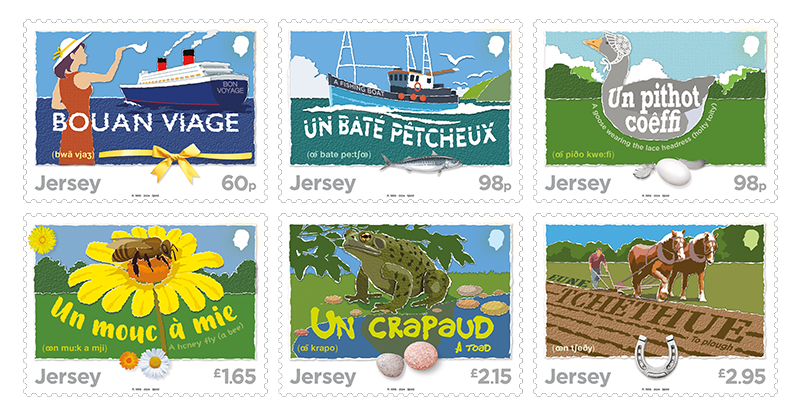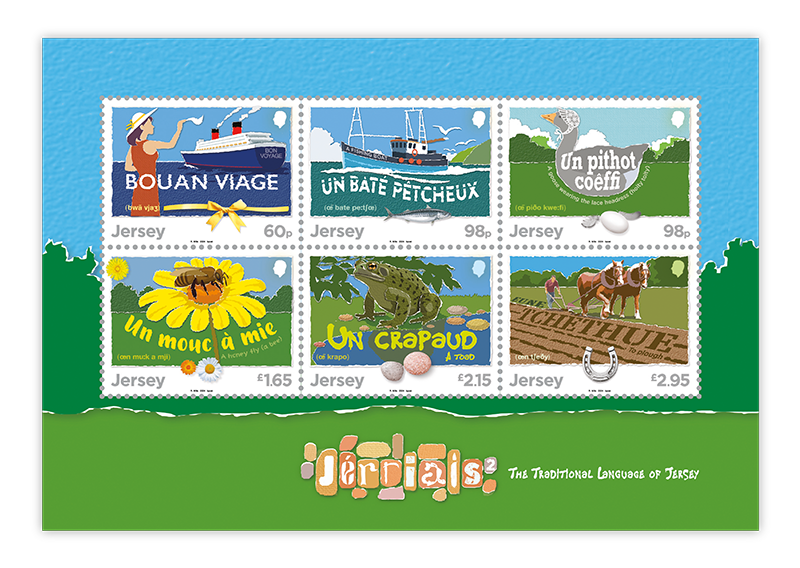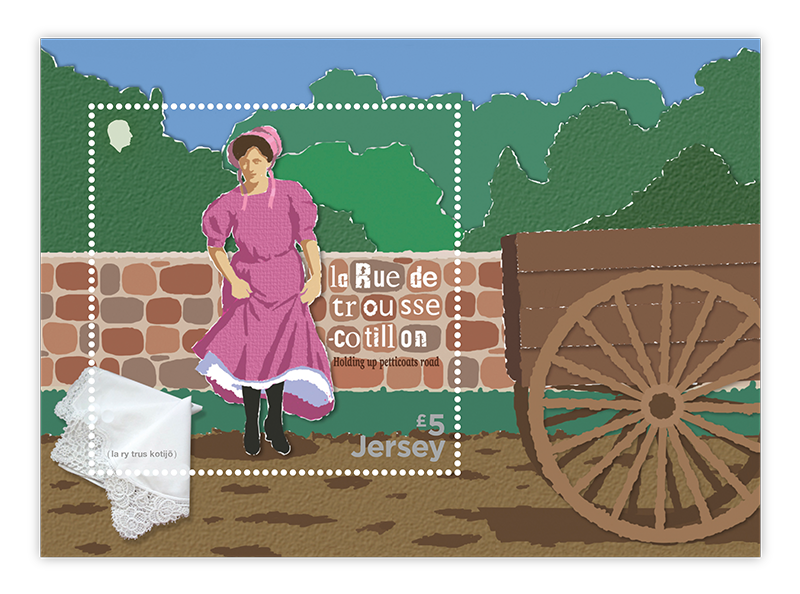Jèrriais 2 a Celebration of Native Languages
October 1, 2024

Issued on Thursday 3rd October 2024, ‘Jèrriais 2’ celebrates Jersey’s traditional native language in the second part of the Jèrriais series. Local artist, Ron Mills, who illustrated the 2022 issue ‘Jèrriais – The Traditional Language of Jersey’ returned to use his stylistic illustrations skills to highlight the uniqueness of the Jèrriais language. Jèrriais phrases and words can be found throughout the Island showcasing the significant role the language has played in shaping the Island’s culture and history.
‘Jèrriais 2’ includes a set of six stamps, a souvenir sheetlet and a miniature sheet, which all feature various phrases used within the language. For the 60p stamp, Ron has depicted a woman waving to a ship with the Jèrriais phrase Bouan Viage signifying a wish of a ‘good voyage’ the pronunciation is similar to the French ‘bon voyage’.

Both Jèrriais and Jersey’s fishing industry have existed for a number of years in Jersey. The Jèrriais for a fishing boat has been illustrated in the first 98p as Un baté pêtcheux. Ron Mills, has also included the pronunciation œ̃ bate pe:tʃœ in the left hand corner of the stamp.
The second 98p includes a very fun phrase of referring to someone as a bit hoity toity. Un pithot coêffi pronounced as œ̃ piðo kwe:fi literally translates to a goose wearing a headdress. The connotation is that geese have particularly long necks, but the thought of them looking down at someone while wearing a headdress is a little ridiculous, hence the double meaning of the phrase as hoity toity.
For the £1.65 stamp the Jèrriais term Un mouc á mie translates to a honey fly (bee).The French word for bee is ‘abeille’ but they also have a French translation for a honey fly ‘mouche de miel’, which is more similar to the Jèrriais phrase and most likely used before ‘bee’.
Likely one of the most well-known Jèrriais phrase on the Island, Un crapaud pronounced as œ̃ krapo. Jersey’s local toad is called a crapaud. And previously the phrase Un crapaud was meant to be an insulting way to describe someone from Jersey, however locals took an ironic pride in the name, to the point that in St. Helier a stone crapaud stands proudly on a pillar within an area of the town.
Translated to mean to plough, the £2.95 stamp features the Jèrriais phrase Eune tchéthue, pronounced as œn tʃeðy. The illustration of the stamp features a farmer ploughing a field. Jersey’s rich natural soil has been used to farm an array of fruits and vegetables throughout the years. Ploughing is used in farming to break down and loosen the soil to ensure the area is ready for sowing seeds for planting.

For the miniature sheet, a woman can be seen holding up her petticoat. Prior to the 17th century when an order was placed to ensure the roads were paved, many of the streets in town were narrow and difficult to travel over. As they were unpaved there were no clear paths for pedestrian use and come the winter months traversing the streets was almost impossible and people had to mind their steps.
If you were to look up the Jèrriais translation for many of the road names in Jersey, you’d soon discover that the language was used to give Islanders an understanding of what to expect when traversing them. As such La Rue Trousse Cotillon, which literally translates to ‘holding up petticoats road’, was known to be rather muddy. Therefore, people, particularly women had to mind their steps.
The language is now being taught in schools in Jersey to ensure the language isn’t forgotten. Currently, fluent speakers of the language are in the minority, however, Jersey’s society’s, such as the Société Jersiaise are keen on encouraging the native language of Jersey, holding various social gatherings and online courses which can be accessed both locally and internationally. Jersey Post would also like to state a special thanks to Geraint Jennings from the Société Jersiaise, and authors of Titchi Pitchi Tracy Peters and Jo Olszewski for assisting in the research of this issue.
